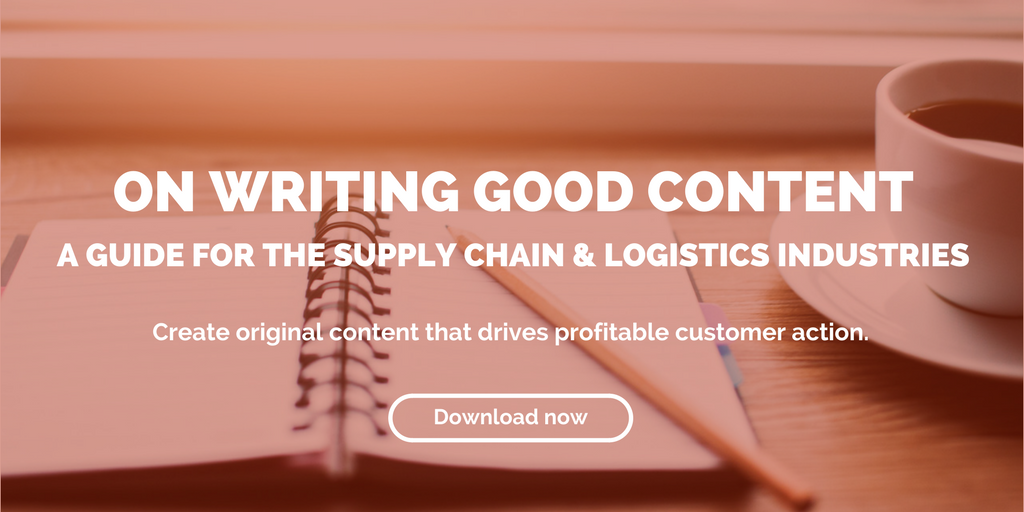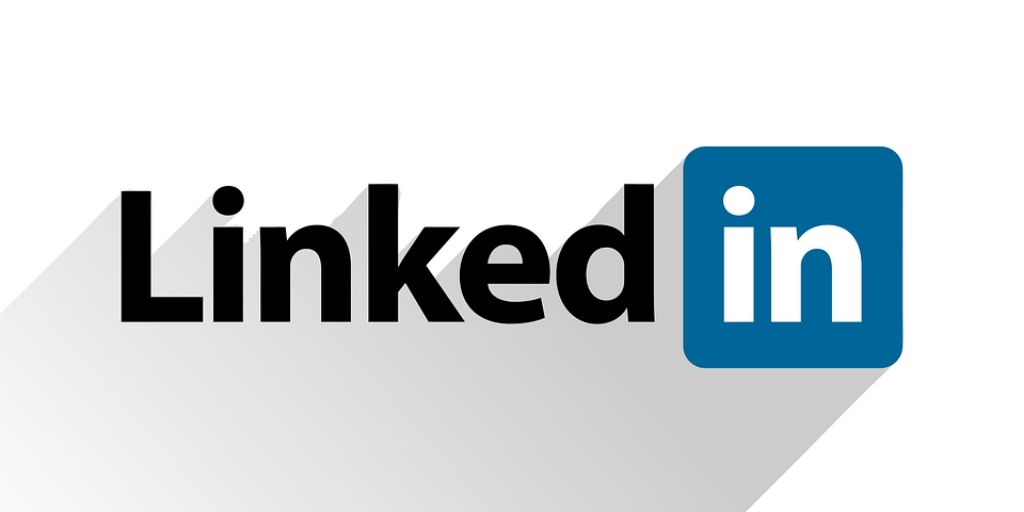
by Fronetics | Nov 5, 2019 | Blog, Content Marketing, Logistics, Marketing, Social Media, Supply Chain
LinkedIn has released a new guide to using video on its platform. Here’s what supply chain companies need to know to get the most out of video on LinkedIn.
Highlights:
- Effective B2B marketing videos start with an analysis of your prospects’ unique purchasing journey and needs.
- Videos for the awareness stage of the buyer’s journey should be concise and geared to forging an emotional connection.
- Bottom-of-the-funnel video types include product demonstrations, welcome videos, webinars, and FAQ sessions.
Visual content, particularly video, is the future of social media marketing. And video on LinkedIn is no exception. A recent report from Kleiner Perkins indicates that 62% of B2B marketers rate video as an effective content-marketing tactic. Not only that, but, according to internal data from LinkedIn, users are 20 times more likely to share a video on the platform than any other type of content.
Thanks to a recent guide published by the platform, leveraging video on LinkedIn for the supply chain has never been more attainable. The Tech Marketer’s Guide to B2B Video is an invaluable resource. Whether you’re relatively new to B2B video marketing, or a seasoned video creator, the guide contains useful nuggets of information, as well as examples of effective video on LinkedIn, for marketers at any stage.
We’ve pulled out key points for you.
6 steps to approaching video on LinkedIn
It’s worth pointing out that the six steps that LinkedIn identifies to building an effective video strategy are applicable elsewhere as well. Your strategy for video on LinkedIn should likely also apply to your strategy for video content across your digital assets.
1) Analyze your buyer’s journey
Consider the unique buyer’s journey for your company. What content do prospects want to see at each stage, and what actions do you want them to take?
2) Set your marketing strategy
What medium is optimal for delivering content at each stage? Which stages are particularly conducive to video content?
3) Establish metrics and KPIs
Choosing the right key performance indicators (KPIs) and metrics will allow you to determine how your content is performing.
4) Create video content
At the stages where video content is the best way to deliver, what type of video is most effective?
5) Target your content
Use your understanding of your target audiences, in combination with the targeting capabilities of LinkedIn, to ensure that your video is reaching the right people at the right times.
6) Optimize your campaign
Keep track of your data. Note what’s working. Adjust what isn’t performing.
Using video on LinkedIn throughout the buyer’s journey
Awareness
The first stage of the buyer’s journey, the awareness stage, is particularly opportune for video on LinkedIn. At this point, your goal is to tell a story, evoke a response, and introduce your brand and products.
Videos at this stage should be concise and geared to connecting with your audience, demonstrating an understanding of their challenges, and how your company is positioned to address those challenges.
LinkedIn’s guide points out a major advantage of video: its measurability. As opposed to text-based marketing, where your knowledge of audience behavior is limited to downloads and time on page, video on LinkedIn comes with richer data. You can tell, for example, when someone has watched your video and when they stopped. This means you can adjust your video length suit the preferences of your audience.
At the awareness stage, important video metrics include how many times your video was viewed, how much of the video was watched, and how many viewers responded to your call to action.
Consideration
Using video on LinkedIn for the second stage of the buyer’s journey, the consideration stage, is about introducing your products and their features, as well as giving a sense of what it’s like to work with your business. Ideal video formats at this stage include explainers, case studies, webinars, how-to videos, and virtual tours. Your foremost goal is to be authentic and to represent your business and the solutions it offers.
Key metrics at this stage are about engagement. Keep track of the number of interactions your videos get (comments, likes, clicks, shares, etc.), compared to the number of views. Also keep an eye on your estimated cost per view (eCPV) to track the efficacy of your video budget.
Decision
Because the decision phase of the buyer’s journey is all about personalization, video has traditionally been used less here. But that’s starting to change. Authentic, trust-building videos can be a powerful asset for the decision stage, reassuring your prospects that they’re making the right decision, using testimonials from existing customers. Welcome videos, FAQ sessions, and webinars are also effective in the decision phase, as well as full-length product demonstrations.
If you’re using lead-generation forms with your video on LinkedIn, keep track of which generate the most leads, as well as the quality of those leads. Otherwise, track click-through rates to gain insights into your estimated cost per click (eCPC).
Metrics for video on LinkedIn
LinkedIn offers a robust set of metrics for videos on its platforms:
- Views: At least one second of playback while the video is at least 50% on screen on desktop, or 300 milliseconds on mobile
- Views at 25%: The number of times your video was watched at 25% of its length, including watches that skipped to this point
- Views at 50%: The number of times your video was watched at 50% of its length, including watches that skipped to this point
- Views at 75%: The number of times your video was watched at 75% of its length, including watches that skipped to this point
- Completions: The number of times your video was watched at 97-100% of its length, including watches that skipped to this point
- Completion Rate: Completions divided by views as a percentage
- View Rate: Number of views divided by impressions, multiplied by 100
- eCPV: Estimated cost per view
- Full Screen Plays: Total number of clicks to view video in full screen
Do you use video on LinkedIn for your business? Let us know your experience in the comments.
Related posts:


by Fronetics | Aug 6, 2019 | Blog, Content Marketing, Marketing, Supply Chain
Integrating marketing and innovation early in development paves the way for new products to succeed.
Highlights:
- In many organizations, marketing is declining and moving downstream.
- Innovation needs marketing to be successful, and the earlier marketers are involved, the greater the chances of success.
- Marketers can help innovations succeed by identifying buyer needs, understanding what makes a product attractive, generating buyer engagement, and more.
With the emergence of automation and artificial intelligence (AI) technologies, some companies are putting marketing on the back burner when it comes to allocating resources. While these technologies are invaluable tools for marketers, they should not be supplanting a robust marketing presence. Marketing matters now more than ever, and integrating marketing and innovation is perhaps the best thing businesses can do to create competitive advantage.
Brand-building expert and author Denise Lee Yohn writes that despite the recent decline of marketing and its consequent move downstream, “the full, business-growing power of the marketing function comes way upstream – from creating markets.” This is particularly true when it comes to innovation development. Simply put, innovation needs marketing.
When marketers are involved upstream in development discussions in the innovation process, businesses integrate the power of marketing and innovation. As Yohn puts it, “Strategic, upstream marketing that is incorporated into the innovation development process can clearly define who to sell the new offering to and how to sell it.”
5 ways integrating marketing and innovation leads to greater success
1) Identifying buyer needs
When an innovative design or process hits the market, its success can hinge on whether it meets (or is perceived to meet) an existing unmet buyer need. When marketers are involved early in the development stages of an innovation, they can offer valuable contributions about the needs of the target buyer persona. These contributions can help shape product development, and marketers are in turn able to preemptively drive interest and start generating leads before a new product even hits the market.
2) Understanding what makes a product attractive
Marketers have the knowledge and expertise to analyze buyer trends and address what Yohn describes as “the cultural, social, and psychological dynamics that should be addressed in the development of and communication about an innovative product.” In other words, involving marketers upstream helps shape product development toward marketability.
3) Generating buyer engagement
When engineers or designer talk about a product, they tend to focus on what it can do. When marketers talk about a product, they focus on what it can do for a target buyer persona. Particularly when it comes to marketing breakthrough innovations, buyers need to be educated about why they’re necessary. Marketing and innovation can work hand-in-hand to engage a target buyer segment by emphasizing the aspects of an innovation that make it directly beneficial.
4) Providing context
To illustrate how marketing can help “develop the entire customer experience ecosystem,” Yohn uses the example of the failure of the Sony e-reader as opposed to the success of the Amazon Kindle. Because Amazon integrated marketing and innovation early in the process, when the product launched, “it offered an integrated experience of hardware, software, service, and content.” In other words, marketers can provide necessary context for the launch of a new product to ensure that it launches into a market that’s ready to recognize its value.
5) Shaping go-to-market strategy
When marketers are involved from the development stage of a product, they can begin to develop an optimal go-to-market strategy. Marketers can identify the right channels to ensure that the product gets to the target buyer segment, as well as begin promotional efforts early in the process.
When combined strategically, marketing and innovation share a symbiotic relationship. As Yohn puts it, “Marketing needs to be less about what happens after an innovation is ready to launch, and more about getting it to be ready in the first place.”
Businesses that recognize the value of integrating and embracing marketing organization-wide stand at a significant competitive advantage.
Related links:


by Jennifer Hart Yim | Aug 24, 2017 | Blog, Content Marketing, Manufacturing & Distribution, Marketing, Supply Chain
Here are seven tips for manufacturers to improve your email marketing strategy in the manufacturing and industrial sector.
This post comes to us from Adam Robinson of Cerasis, a top freight logistics company and truckload freight broker.
Email marketing is a powerful tool for growing and developing different types of businesses. However, many industries are still unaware of the power of using an appropriate email marketing strategy. Many manufacturers and industrial companies are still stuck in the one-off batch and blast mode of email marketing. That strategy is not likely to work very well in industrial marketing, where most of the purchases are expensive; complex products with long sales cycles, multiple decision-makers, and stakeholders are involved; and there is a much higher risk if a wrong decision is made.
7 email marketing tips for manufacturers
1. Avoid SPAM at all costs
The last thing that you want is for your emails to end up in someone’s spam folder or have your emails banned from someone’s inbox. Before you even start an email marketing campaign, you should print out the latest copy of the CAN-SPAM act to remind yourself of some email marketing principles, such as any recipient must have given their consent before receiving commercial email, have an option to unsubscribe from receiving further emails, do not mislead the recipient about the content or the origin of the email, and use approved methods to get a recipient’s email address.
2. Personalize your emails
You should avoid sending generic emails. Your recipients are not all the same, and you should make distinctions between them by segmenting your database. This means sending the same type of email diversified in some key aspects depending on the type of recipient. The content and filters of platforms such as Litmus and Reach Mail, which is based on personal data, geography, activity, and devices used, let you automate the entire process to narrow your focus and identify the ideal sub-section of your list.
3. Increase your traffic and clicks
By creating the perfect email marketing campaign, you will have the power to turn emails into clicks and traffic to your website. Sending relevant links to your subscribers will drive them to your website, and this increases the potential for new sales. If you want to give a real boost to your click-thru rates, you should keep in mind that you have to get rid of the clutter. Having an email that has too many graphics and banners will confuse your readers and leave them wondering what they are supposed to click on.
4. Offer quality content
You should always provide useful, quality content in an email and links to further information. Your emails should be more informative than sales-related, especially in the manufacturing industry. Talk about your company’s safety standards, advertise interviews with experts, and discuss pressing matters in your industry. Not presenting your information in a clear and accurate way will put off your recipients. You can take advantage of online tools to help you with your content writing. Use Australian Help and Oxessays as copywriting tools for writing your emails and Bigassignments to help you to edit your content. [Editor’s note: You can also partner with a third-party marketing firm to develop and execute an email marketing strategy for your business.]
5. Optimize your subscriber list
Do not rush out and buy an email list to get started with email marketing. You should grow your in-house subscriber list and get to know your customers and what they need from you.
6. Link your email platform with other channels
Email platforms, external databases, e-commerce, social media, and business intelligence systems can all be linked to optimize your business and reach more potential clients. Platforms such as Mail Chimp and Mad Mimi allow you to connect and integrate every system, synchronize the information on each, and have them communicate with each other.
7. Automation and tracking
You should try to make your email marketing strategy as efficient as possible with email marketing automation. Platforms such as the mentioned Litmus and Reach Mail will let you automate the entire process. Analyzing and tracking your campaigns’ performance is also essential. Using the analysis tools and reports available from the platforms we suggested will allow you to check and optimize your clicks, traffic, and sales.
Wrapping up the 7 email tips for manufacturers
There are many things to consider when creating an email marketing campaign. The main goal is to effectively connect with potential customers to persuade them to purchase your product by reminding them that you exist and that you are helping. Use these email tips for manufacturers to continually improve your sales and grow your industrial business.
Related posts:
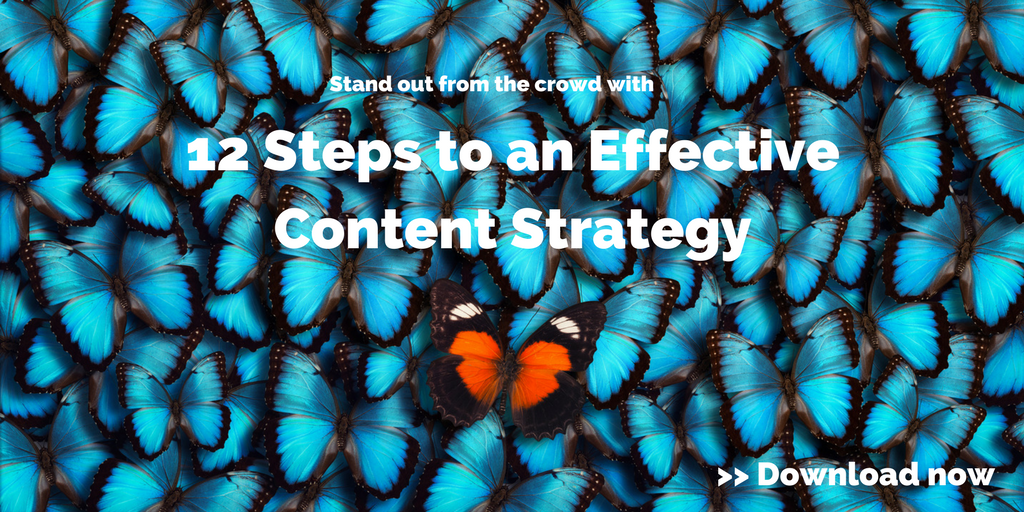

by Fronetics | Jan 12, 2017 | Blog, Content Marketing, Marketing, Social Media, Strategy
Competitive benchmarking should be part of your data-driven marketing strategy.
In August 2016, Elaine Thompson claimed the mantle of world’s fastest woman, and Michael Phelps became the most decorated Olympian of all time. Thompson and Phelps achieved these incredible feats by continuously pushing themselves to do better. To do this, they not only tracked and measured their personal performance, but they also tracked the performance of their peers and of their competitors. Together, this data gave Thompson and Phelps the knowledge and drive needed to improve their own performance.
When it comes to measuring marketing performance, most marketers look inward, focusing on key performance indictors (KPIs) such as website traffic, open rates, social engagement metrics, and conversion rates. While these inward facing KPIs are important, it is also important to look at what is happening outside your organization and to benchmark your marketing performance against peers and competitors. This will give you the knowledge and drive you need to improve your performance and chance of success. It can help you to identify threats and strategic opportunities.
WHO
When adding competitive benchmarking to your marketing strategy the first step is to determine who to benchmark against. I recommend not just benchmarking against direct competitors, but to also benchmark against industry leaders, and against a company or two that you think is excelling (this company does not need to be in your industry). By taking this more global view, you can gain ideas and intelligence from industry leaders and from the creative and strategic minds of top performers. A word of caution – be strategic and keep the number of companies to a reasonable number.
WHAT
While you should determine the KPIs to track and measure based on your business and marketing goals, here are some to consider:
- Traffic by channel
- Visits by source
- Bounce rate
- Keywords
- PPC activity and spending
- Social engagement
- Social reach
- Posting times
- Top performing content
- Meta description (company positioning)
As with your inward facing KPIs, action is key. Use the data you gather to inform your strategy.
You might also like:
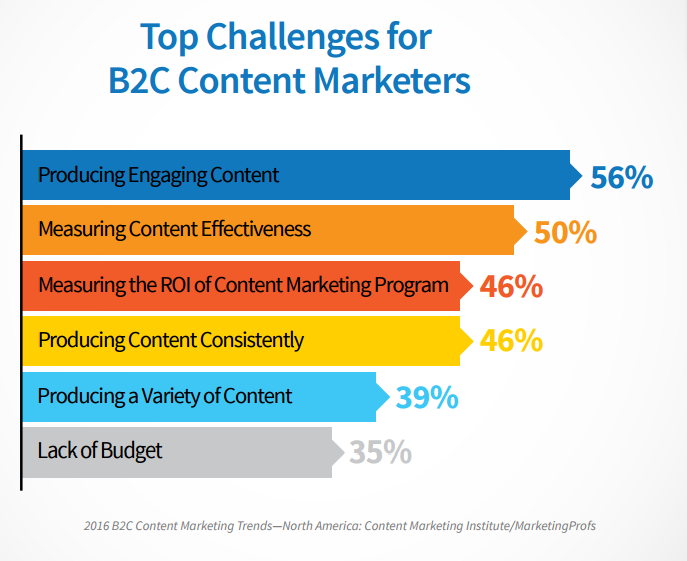
by Fronetics | May 17, 2016 | Blog, Content Marketing, Marketing, Strategy
Producing engaging content is the number one challenge for content marketers.
Is content marketing working well for your business? If not, you are not alone. Though it is one of the most effective ways to grow your business, content marketing has been challenging B2B and B2C organizations since its inception.
You may think it should be simple: Write, post, get more customers. But content marketing is much more complex, demanding more time, thought, and careful strategy than churning out a few blog posts. First and foremost, what you produce must engage readers. This is, however, the biggest content marketing challenge facing both B2B and B2C marketers.
2016 reports produced by Content Marketing Institute and MarketingProfs, and sponsored by Brightcove, found that the number one challenge for B2B and B2C marketers is producing engaging content.

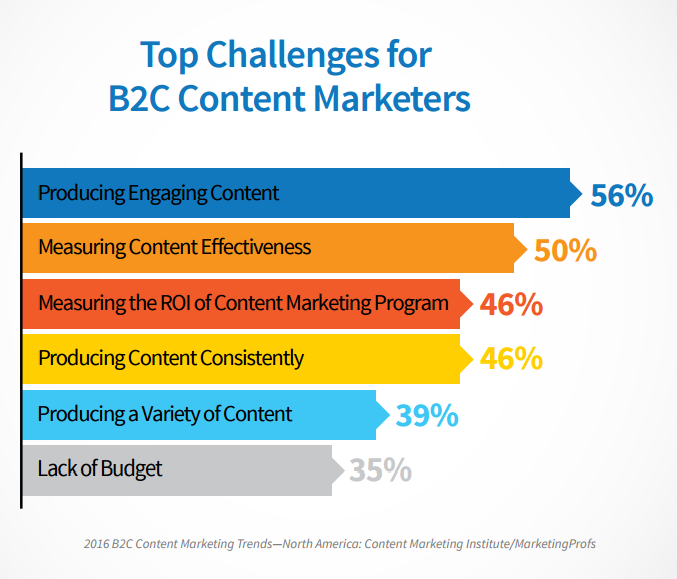
Dull content and the domino effect
Unfortunately, if you lack engaging content, it works like a domino, knocking down all your other marketing efforts.
For one, it is much easier to gain the support of the C-suite, and be granted a reasonable budget, for your content marketing plan if you can show that your strategy is attracting more customers, helping with conversions, and driving sales. But if your content is not producing results, you won’t get the support and resources you need to produce the content, which, in turn, fuels results. It is a vicious cycle.
That being said, lack of engaging, quality content may be indicative of other challenges you may be facing, like the resources to produce content.
Creating engaging content
There are a few basics you must address if you are going to produce engaging content:
- Research your customer demographic. You must know who your audience is, what they want to know, how they want to learn it, and where to find them. Use web analytics to learn how your audience interacts with your website, what kinds of posts and emails they are reading, and where improvements can be made.
- Do your due diligence and learn how to reach those potential customers with topical information they want and will read. This means conducting a solid analysis of trends in your industry and producing content that offers expert information on these subjects or answers pressing questions potential customers may have about them. You, thus, will establish your organization as a trusted voice for your industry. This leads to dialogue with prospects and customers that want to learn more from you about industry news — or, even better, who are interested in your products or services.
- Research your distribution channels. This can affect not only what you post, but where and when you post it. Know your target’s social media habits, when they read emails, and what they are looking for. Research your competition and learn which channels they focus their attention on and why. Read the latest industry publications and influential blogs to uncover what topics work to engage their readers. Look for trends and answer to them.
- Look at SEO evaluations and site audits to help identify new middle- and bottom-of-the-funnel opportunities for content.
- Tell a story.
If creating engaging content has proven to be challenging for your business, consider outsourcing your content creation, or your marketing program all together. According to Social Media Today, lack of marketing staff can make it difficult for organizations to produce enough content to keep up with their competition.
Quality research and consistent creation of engaging, relevant content is time-consuming and requires keen writing skills. Promoting your posts on social media also takes time and requires consistent effort. Some of the most successful organizations put this task in the hands of an expert that can create and leverage content to provide the greatest impact to your brand, lead generation, and new customer conversion rate.
Related posts:
